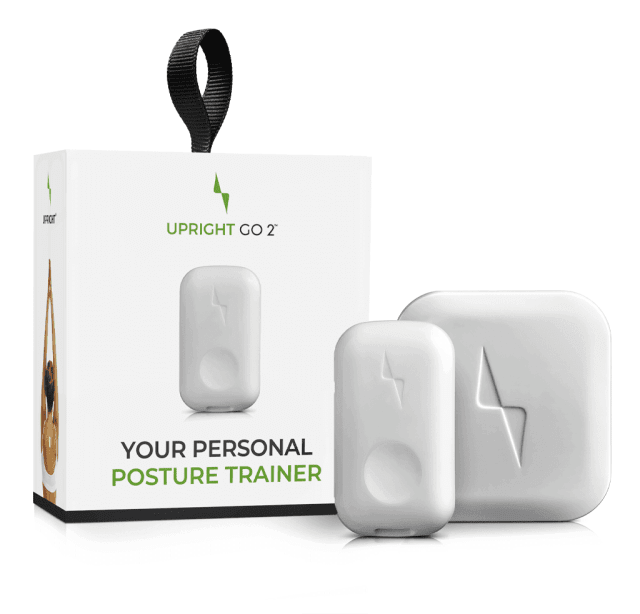Kyphosis: The Hunch Back Posture
Upright

What is a Hunch Back?
A hunch back, also known as hunchback posture or medically as Kyphosis, is when your upper back curves more than normal, creating a hunched or rounded appearance. While Hollywood has portrayed having a hunch back as abnormal and irreversible, it’s actually much more common and treatable than you realize.
It’s normal for your upper back to have a slight curve that helps support the weight of your head and absorb shock. But a hunch back occurs when this natural curve becomes much more pronounced, forming a visible hump on your back. A hunch back doesn’t only create the appearance of slouching – it can also lead to painful pressure on your spine and affect your daily life.
Let’s take a closer look at what causes a hunch back, treatment options, and how to fix your posture before it gets worse.
What Causes a Hunch Back?
Understanding what causes hunchback posture is the first step to preventing it. A hunch back can affect anyone, but certain causes are more preventable than others.
Common Causes of Hunch Back:
Poor Posture (Most Common)
The most common cause of a hunch back is simply poor posture over time. When you constantly slouch, hunch over your computer, or look down at your phone, your spine gradually adapts to this position. This type of hunchback posture is called postural kyphosis and is completely preventable.
Age-Related Changes
As we age, our bones can weaken (osteoporosis) and our muscles lose strength. This makes it harder to maintain good posture, leading to a gradual development of hunch back posture.
Medical Conditions
Several medical conditions can contribute to developing a hunch back:
- Osteoporosis: Weakened bones that can compress
- Arthritis: Joint inflammation affecting spine alignment
- Scheuermann’s disease: A condition affecting spine development in teens
- Spinal injuries: Trauma that affects spine alignment
- Muscle weakness: Weak back and core muscles
Lifestyle Factors
Modern lifestyle habits that contribute to hunchback posture include:
- Spending long hours at a computer
- Constantly looking down at phones or tablets
- Lack of regular exercise
- Poor sleeping positions
- Carrying heavy bags on one shoulder
What Does a Hunchback Look Like?
Many people wonder “what does a hunchback look like?” and whether they might be developing one. Here are the visual signs of hunchback posture:
Physical Signs of a Hunch Back:
- Rounded shoulders: Shoulders that roll forward instead of sitting back
- Forward head position: Your head juts forward instead of sitting over your shoulders
- Visible upper back curve: An exaggerated curve in your upper back
- Hunched appearance: Overall appearance of “hunching over”
- Reduced height: You may appear shorter due to the curved posture
How to Check if You Have Hunchback Posture:
- Wall test: Stand with your back against a wall. If your head doesn’t touch the wall naturally, you may have forward head posture
- Mirror check: Look at yourself from the side in a mirror. Notice if your shoulders are rounded forward
- Photo analysis: Take or look at recent side-view photos of yourself
When Should I Seek Treatment for a Hunch Back?
If you only have a slight hunch back, you may not need professional treatment immediately. However, you should consider seeking help if you’re experiencing:
Warning Signs That Need Attention:
- Pain: Persistent back, neck, or shoulder pain
- Breathing difficulties: Trouble taking deep breaths
- Fatigue: Constant tiredness from poor posture
- Worsening appearance: Noticeable progression of the hunch
- Reduced mobility: Difficulty with daily activities
- Self-consciousness: Feeling embarrassed about your appearance
Because so much of your movement depends on your spine’s health, it’s important to address any spine-related issues early. This can help reduce the risk of more serious complications, including chronic back pain and arthritis, down the line.
How to Fix a Hunch Back: Treatment Options
The good news is that many cases of hunch back, especially those caused by poor posture, can be improved or even reversed with the right approach.
Non-Surgical Treatments for Hunch Back:
1. Posture Correction
For postural hunchback (the most common type), improving your daily posture is the most effective treatment. This involves:
- Learning proper sitting and standing positions
- Using ergonomic furniture and accessories
- Taking regular breaks from sitting
- Being mindful of your posture throughout the day
2. Physical Therapy
A physical therapist can help you:
- Strengthen your back and core muscles
- Improve flexibility and range of motion
- Learn specific exercises to counteract hunchback posture
- Develop a personalized exercise routine
3. Targeted Exercises
Specific exercises that help fix hunchback posture include:
- Chest stretches: To open up tight chest muscles
- Upper back strengthening: Rows, reverse flies, and wall slides
- Core strengthening: Planks and dead bugs
- Neck stretches: To address forward head posture
4. Lifestyle Modifications
Simple changes that can help fix your hunch back:
- Adjust your computer screen to eye level
- Use a supportive chair with good back support
- Sleep with proper pillow support
- Carry bags evenly distributed
- Take frequent posture breaks
When Professional Treatment is Needed:
Observation
For mild cases, your doctor may recommend regular check-ups to monitor whether the hunch back is progressing or improving.
Back Braces
In some cases, especially for growing teenagers, doctors may recommend wearing a back brace to prevent the curve from worsening.
Surgery
Surgery is rarely necessary and is typically only considered for severe cases that cause significant pain or breathing problems.
How to Prevent a Hunch Back
Prevention is always better than treatment when it comes to hunchback posture. Here’s how you can prevent developing a hunch back:
Daily Habits to Prevent Hunch Back:
1. Practice Good Posture
The most important step is to maintain good posture throughout the day:
- Keep your shoulders back and down
- Align your ears over your shoulders
- Engage your core muscles
- Distribute weight evenly on both feet when standing
2. Set Up an Ergonomic Workspace
Since many people develop hunchback posture from desk work:
- Position your computer screen at eye level
- Use a chair that supports your lower back
- Keep your feet flat on the floor
- Take breaks every 30-60 minutes to stand and stretch
3. Strengthen Your Body
Get Enough Protein
Protein helps maintain muscle health, which supports good posture. Strong muscles are essential for supporting your spine and preventing a hunch back.
Do Strength Training
Regular strength training helps prevent hunchback posture by:
- Building strong back muscles to support your spine
- Strengthening your core for better stability
- Improving overall bone density
- Counteracting the effects of prolonged sitting
Effective exercises include rows, deadlifts, planks, and overhead presses. Always use appropriate weights and proper form.
4. Avoid Harmful Positions
Try to minimize activities that promote hunching:
- Limit time spent looking down at phones
- Avoid slouching while sitting
- Don’t carry heavy bags on one shoulder
- Be mindful of your posture while driving
5. Support Your Bone Health
Don’t Smoke
Smoking can weaken your bones and increase the risk of developing a hunch back due to spinal fractures.
Monitor Your Bone Health
Regular bone density screenings can help identify problems early, especially if you’re at risk for osteoporosis.
Get Adequate Calcium and Vitamin D
These nutrients are essential for maintaining strong bones that can support good posture and prevent hunchback development.
Simple Exercises to Fix Hunchback Posture
Here are some easy exercises you can do at home to help improve hunchback posture:
Daily Posture Exercises (5-10 minutes):
1. Wall Slides
Stand with your back against a wall, slide your arms up and down while keeping contact with the wall. This strengthens your upper back and improves posture awareness.
2. Doorway Chest Stretch
Place your forearms on a doorway and gently step forward to stretch tight chest muscles that contribute to hunched posture.
3. Cat-Cow Stretch
On hands and knees, alternate between arching and rounding your back to improve spinal flexibility.
4. Chin Tucks
Sit or stand tall and gently pull your chin back to counteract forward head posture.
Strengthening Exercises (2-3 times per week):
1. Rows
Use resistance bands or light weights to strengthen the muscles between your shoulder blades.
2. Reverse Flies
Target the rear deltoids and rhomboids to pull your shoulders back into proper position.
3. Planks
Strengthen your core to provide better support for your spine.
Technology Solutions for Hunch Back Prevention
While exercises and awareness are crucial, modern technology can also help prevent and fix hunchback posture:
Posture Training Devices
Wearable devices like posture trainers can provide real-time feedback about your posture throughout the day. These devices gently vibrate when you slouch, helping you develop better posture habits unconsciously.
Apps and Reminders
Smartphone apps can remind you to check your posture regularly and provide guided exercises to counteract hunching.
Stay Ahead of the Hunch: Take Action Today
A hunch back may sound concerning, but it’s highly treatable when you take the right steps. The key is early intervention and consistent effort. Whether you’re trying to prevent a hunch back from developing or fix existing hunchback posture, the sooner you start, the better your results will be.
Remember that developing good posture habits takes time, but the benefits extend far beyond just appearance. Good posture can improve your breathing, reduce pain, boost confidence, and enhance your overall quality of life.
Your Action Plan:
- Assess your current posture using the techniques mentioned above
- Start with simple daily habits like posture awareness and regular breaks
- Incorporate targeted exercises into your routine
- Consider professional help if you’re experiencing pain or significant changes
- Use technology to support your posture improvement journey
Although there are many types of hunch back conditions, one common factor that helps in all cases is improving your daily posture. Since remembering to maintain good posture can be challenging, consider using a posture training device that provides gentle reminders throughout the day.
It’s time to take control of your posture and prevent or fix your hunch back. Your future self will thank you for the action you take today.
You Might also Like
Search
Sign up to our newsletter
Follow Us On
Popular
Revisit the GO 2/S Device Setup
How to get started
Finding your upright position
How to find your target upright posture
Calibration
Check out the UPRIGHT GO 2

